11 Best Strawberry Companion Plants (and What Not to Plant Nearby)
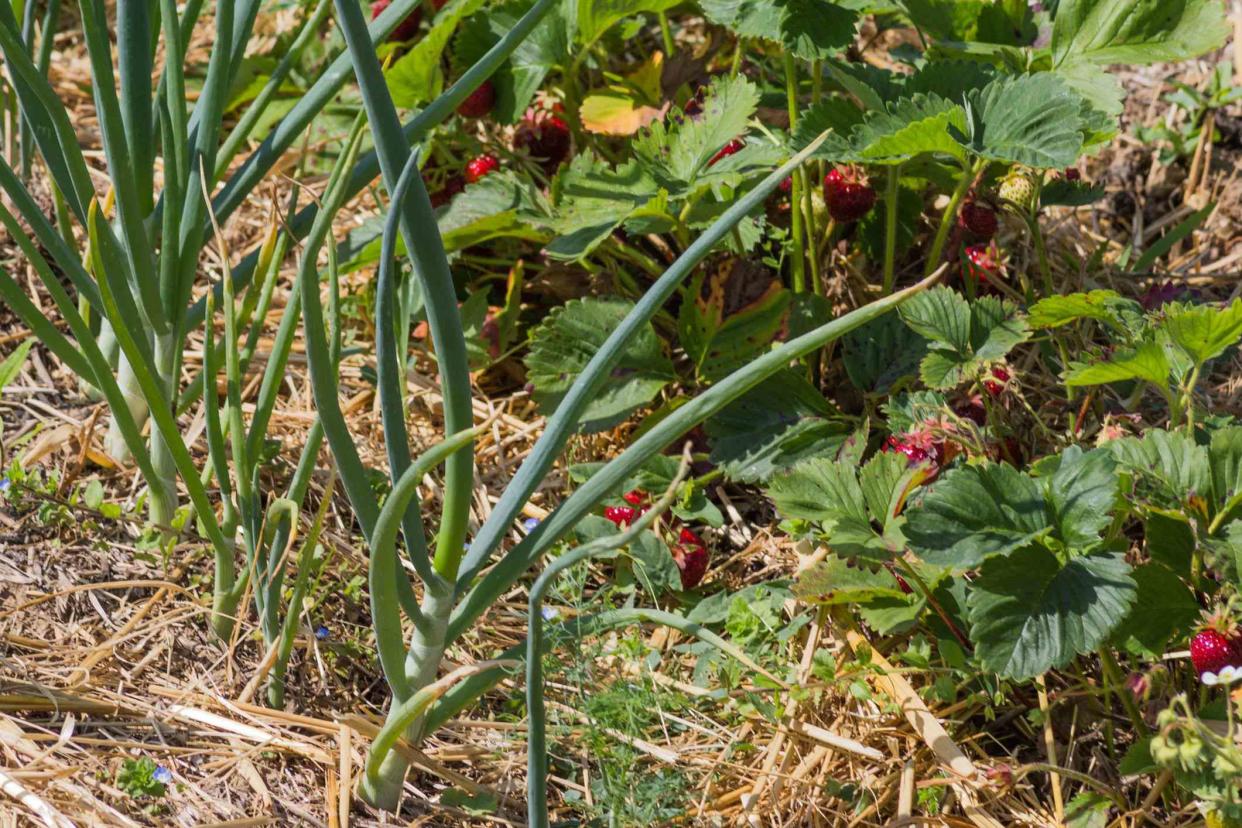
rudolfgeiger / Getty Images
There is nothing sweeter than a homegrown strawberry—but all too often, destructive insects, diseases, and critters smash our hopes for picking lots of the juicy red berries. By carefully selecting what you plant next to your strawberries, you can help your strawberries fight these multiple enemies.
Luckily, there are several plants that repel and deter pests from pests and attract beneficial insects. Read on which 11 plants are good companions for strawberries, and which ones are bad neighbors that should be avoided.
What Is Companion Planting?
Companion planting is the practice of placing plant species near one another for mutual benefit. It can help deter pests, attract beneficial insects and pollinators, and ensure that the nutrient needs of different plant species are not conflicting with each other.
The flipside of companion planting—identifying bad neighbors—is equally important because it helps to contain or prevent the spread of diseases and pests as well as unilateral nutrient depletion of the soil.
Always take companion planting with a grain of salt, as it is mostly based on longtime gardeners' observations. You’ll often find conflicting information about which plants work well as companion plants.
11 Good Companion Plants for Strawberries
Lettuce
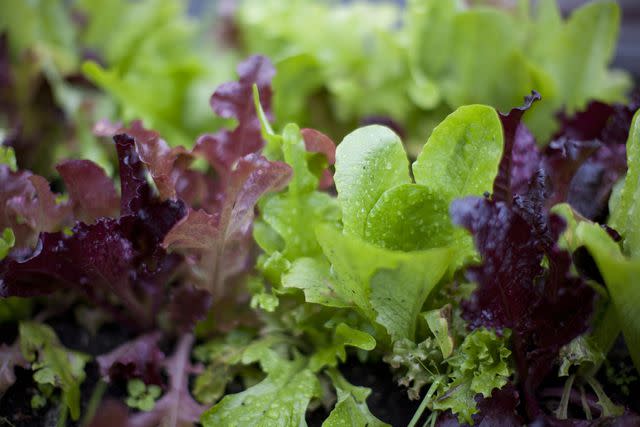
Kodiak Greenwood / Getty Images
The compact size of lettuce makes it a good choice for planting next to strawberries. As leaf lettuces grow larger, they can camouflage the bright red berries from hungry birds.
Alliums

Neyya / Getty Images
Members of the allium family—chives, leeks, onions, and garlic—are all great neighbors for strawberries. There is some evidence that they can help suppress fusarium wilt, a fungus, that can affect strawberries. And their strong odor works as a natural repellent against slugs and aphids.
Chives perform double duty as a strawberry companion plant. It has a strong onion flavor, so if you don’t cut it all and let it reach the flowering stage, it attracts pollinators. Plus, is small enough so that you can tuck it next to your strawberry bed even in a small garden or raised bed.
Spinach
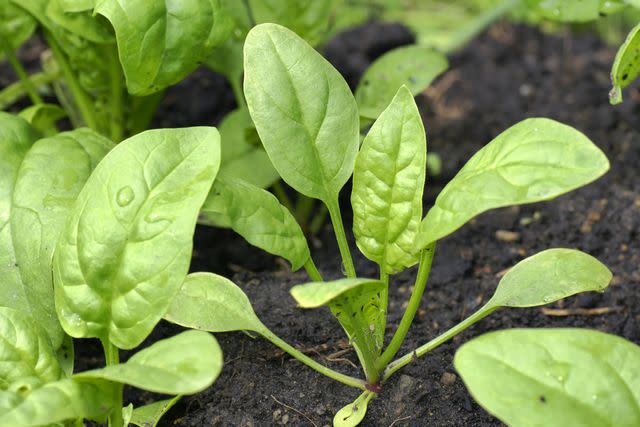
SylvieBouchard / Getty Images
Similar to lettuce, spinach is a compact, cool-season plant whose leaves can disguise ripe berries from predators. The saponins in spinach act as a natural repellent of garden pests.
Asparagus
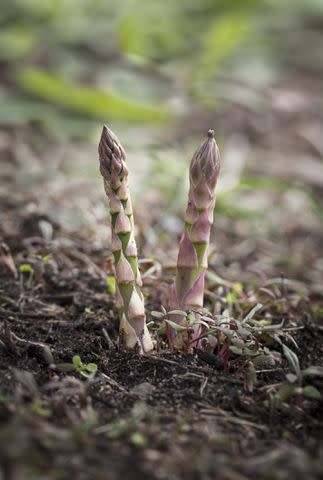
Johner Images / Getty Images
Strawberries and asparagus are a classic springtime pair that is often grown next to each other. Both are perennial edibles with similar growing patterns—they both emerge in the early spring, but they are not in each other’s way, Strawberries have short, shallow root systems whereas the roots of asparagus are 10 to 15 feet deep into the soil.
Dill

Cyndi Monaghan / Getty Images
Some people find the licorice scent of dill overpowering, but for a companion plant, that’s exactly what you want to distract insects from your strawberry plants. Dill's time to shine as a companion plant, however, comes when it has started to flower.
The large umbels attract beneficial insects such as hoverflies, whose larvae feed primarily on aphids but also eat thrips. For dill all summer long, plant it consecutively, every month or so, starting in the early spring and up until late summer.
Sage

Bonnie McCann / Getty Images
The strong scent of sage has the ability to mask the smell of berry plants for insects and predators. Also, just like other herbs, if you let it bloom, the flowers will attract bees and other pollinators.
Borage
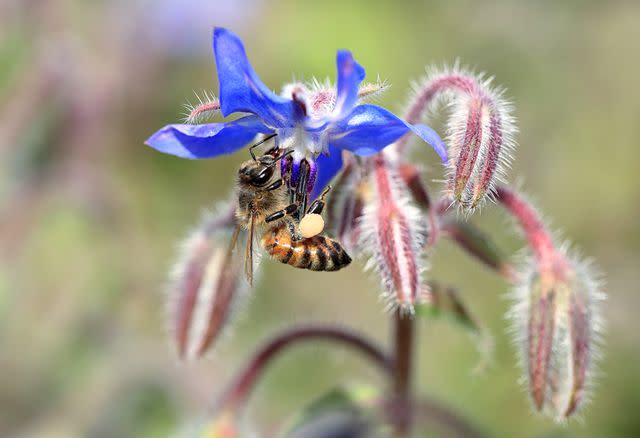
© Jackie Bale / Getty Images
Even if you don’t use borage for cooking (the pretty blue flowers, as well as the cucumber-scented leaves, are edible), make sure to plant it next to your strawberries. Because this prolific bloomer attracts beneficial insects such as parasitic braconid wasps, predatory damsel bugs, and hoverflies, which all keep pests under control.
Borage flowers also attract pollinators, so it not only benefits the strawberries but also other garden crops such as zucchini and summer squash that rely heavily on pollination by insects.
Thyme

dirkr / Getty Images
Letting thyme flower is key to using its benefits as a companion plant. Thyme flowers attract pollinators and beneficial insects such as syrphid flies whose larvae feed on aphids.
Catnip

AlpamayoPhoto / Getty Images
Strawberry aphids and spider mites are two common pests of strawberry plants. The leaves of catnip contain chemicals known as iridoids that act as natural insect repellents.
Yarrow

Catherine McQueen / Getty Images
This perennial ornamental also does double duty as a companion plant. Yarrow attracts beneficial pollinators and repelling critters with the strong scent of its foliage.
Marigolds
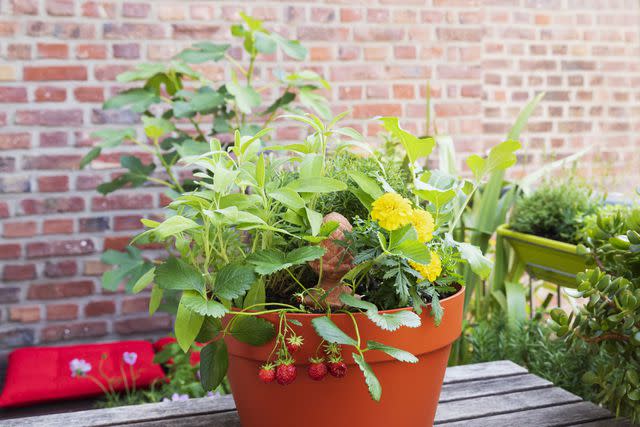
Westend61 / Getty Images
These easy-going annual flowers are one of the most popular plants for natural pest control, and they do a good job for strawberries as well. Their strong scent usually repels predators such as deer, rabbits, and pests.
French marigold varieties have another benefit: they are one of the few plants that produce a substance toxic to root-knot nematodes, which affects many crops, including strawberries. Marigolds are often planted as a trap crop for nematodes.
10 Plants to Avoid Growing Near Strawberries
Avoid planting any of the following next to your strawberries:
Tomatoes: They are prone to verticillium wilt, a fungus that can spread to strawberries.
Eggplant: They are also prone to verticillium wilt.
Potatoes: Spuds have the same issue as eggplants and tomatoes—they can get verticillium wilt.
Peppers: Another member of the nightshade family that is commonly affected by verticillium wilt.
Melons: Not only are melons prone to get verticillium wilt, the long, rambling vines can easily overgrow a strawberry patch.
Winter squash: Pumpkin and winter squashes often get verticillium wilt. Plus, it’s hard to keep the vines from invading your strawberry patch.
Cucumber: All cucumbers can get verticillium wilt.
Mint: Especially in the Pacific Northwest, mint is often affected by verticillium wilt. It might be tempting to plant it next to strawberries because of its strong scent but it’s not recommended.
Okra: Verticillium wilt commonly affects okra, which puts this plant on the list of bad neighbors for strawberries.
Cruciferous vegetables: Not only cabbage but all cruciferous vegetables, including collard greens, kale, cauliflower, kohlrabi, and Brussels sprouts should not be planted next to strawberries because they can stunt each other’s growth.
Read Next:23 Best (and 7 Worst) Companion Plants for Tomatoes

